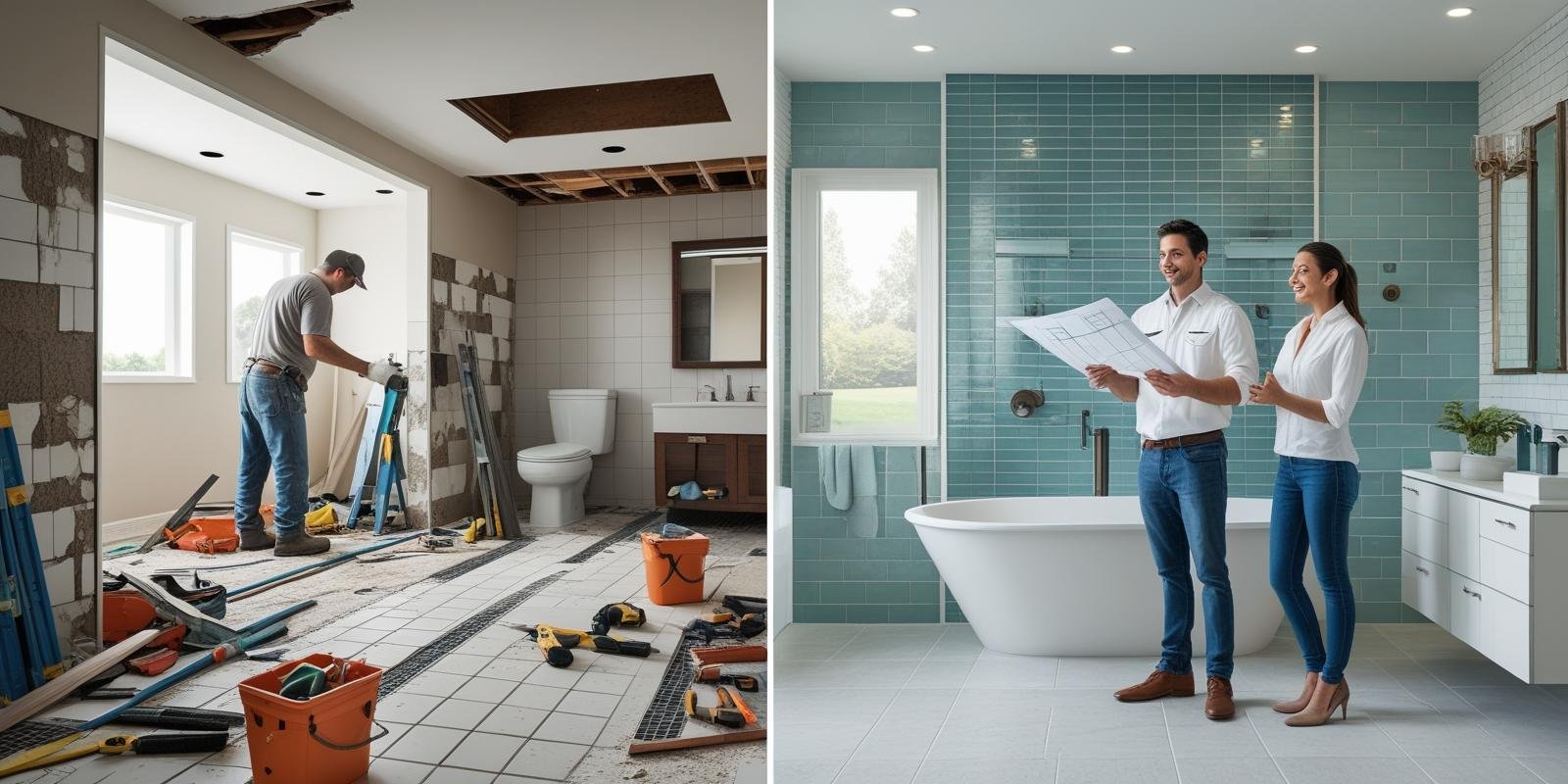Table of Contents
A bathroom remodel is exciting until you’re staring at a list of 20 contractors with no idea who to trust. You’re not alone—choosing the wrong bathroom remodeling professional can lead to cost overruns that drain your savings, poor workmanship that ruins your vision, and worst of all, project abandonment that leaves you with an unusable space for months.
The good news? Finding a reliable, skilled, and fairly-priced bathroom remodel contractor doesn’t have to be a gamble. This comprehensive guide provides you with a proven 10-step system to vet, interview, and hire the perfect professional for your project. By the end of this article, you’ll have access to downloadable checklists, comparison templates, and insider knowledge that will transform you from an uncertain homeowner into a confident project manager.
Key Considerations Before You Start Searching
Before diving into contractor searches, laying the proper groundwork will save you time, money, and frustration. These preliminary steps help you communicate clearly with potential contractors and ensure you’re comparing apples to apples when evaluating bids.

Define Your Project Scope
Understanding exactly what you want determines which type of professional you need to hire. A cosmetic refresh involving new paint, fixtures, and vanity might only require a skilled handyman or specialized bathroom remodeler. However, a full gut renovation that involves moving plumbing lines, electrical work, or structural changes demands a licensed general contractor with bathroom expertise.
Consider whether you’re planning to relocate the toilet, expand the shower, install heated floors, or add windows. These elements significantly impact both the type of contractor you need and your overall bathroom remodel cost guide projections. Document your must-haves versus nice-to-haves early in the process to avoid scope creep later.
Set Your Realistic Budget
Professional bathroom remodels typically break down with labor costs representing 40-65% of your total budget, while materials account for 35-60%. The remaining percentage covers permits, inspections, and unexpected issues that commonly arise in older homes.
Research average costs in your area for similar projects. A modest bathroom refresh might range from $10,000-$25,000, while luxury remodels can exceed $50,000. Remember that extremely low bids often indicate corners will be cut, while excessively high quotes might suggest you’re not the right fit for that contractor’s typical clientele.
Establish Your Timeline
Bathroom remodels typically take 2-6 weeks depending on scope and complexity. Tile work, custom cabinetry, and permit approvals can extend timelines significantly. Be realistic about your family’s tolerance for disruption—living without a functional bathroom creates stress that affects the entire household.
Communicate your ideal timeline and any hard deadlines (such as house guests or special events) upfront. Quality contractors appreciate clients who understand that rushing often compromises workmanship.
The 10-Step Process to Find & Hire the Right Contractor
This systematic approach ensures you’ll identify, evaluate, and select a bathroom contractor who delivers exceptional results on time and within budget.
Step 1: Source Candidates the Right Way
Move beyond simply asking neighbors for recommendations. While personal referrals remain valuable, expand your search using these professional resources:
- National Kitchen & Bath Association (NKBA) directory: These contractors specialize specifically in bathroom and kitchen remodeling
- Houzz platform: Review portfolios, read detailed project descriptions, and see before/after photos
- Local building supply stores: Staff often know which contractors consistently purchase quality materials and maintain good payment relationships
- Better Business Bureau: Search for contractors with strong ratings and resolved complaint histories
Create a list of 5-8 potential candidates before moving to the vetting phase. This gives you options while keeping the evaluation process manageable.
Step 2: The Digital Vetting Process
Online research reveals crucial insights about how contractors operate and treat clients. When reading Google My Business and Houzz reviews, look beyond star ratings to find specific mentions of:
- Communication style: Do clients praise responsiveness and clear updates?
- Cleanliness: Are contractors noted for maintaining tidy worksites?
- Problem-solving: How do they handle unexpected issues or client concerns?
- Timeline adherence: Do projects finish on schedule?
Examine their website for professionalism indicators: a comprehensive portfolio showcasing bathroom projects similar to yours, clearly displayed licenses and insurance information, detailed “about us” sections that establish expertise, and contact information including a physical business address.
Step 3: Verify Licenses and Insurance (Non-Negotiable)
This step protects you from liability and ensures you’re working with legitimate professionals. Every qualified bathroom remodel contractor should carry:
General Liability Insurance: Covers property damage that might occur during your project, such as water damage from a burst pipe or scratches to your hardwood floors.
Workers’ Compensation Insurance: Protects you from liability if a worker is injured on your property during the remodel.
Don’t simply accept a contractor’s word—request current certificates of insurance directly from their insurance company. Additionally, verify their contractor’s license through your state’s official licensing board website. Licensed contractors have met minimum competency requirements and can obtain necessary permits.
Step 4: Analyze Their Portfolio & Past Work
Look beyond pretty staged photos to evaluate actual craftsmanship and consistency. Quality bathroom remodelers should show:
- Consistent workmanship across multiple projects
- Attention to detail in tile alignment, caulking, and fixture installation
- Projects similar in scope and style to your vision
- Before and after photos that demonstrate transformation capabilities
Ask to see a project that encountered problems and how they resolved it. This reveals their problem-solving approach and honesty about challenges that inevitably arise during remodeling.
Step 5: Solicit and Compare Detailed Quotes
Request written estimates from your top 3-4 candidates. Be wary of quotes that are significantly lower than others—they often indicate shortcuts, lower-quality materials, or hidden costs that emerge later.
Quality estimates should itemize:
- Labor costs broken down by trade (plumbing, electrical, tiling, etc.)
- Materials specifications including brands, models, and colors
- Project timeline with specific start and completion dates
- Payment schedule tied to project milestones
- Warranty terms for both labor and materials
Create a comparison spreadsheet to evaluate quotes side-by-side objectively.
Step 6: The Crucial Interview Questions
Go beyond basic questions to uncover how contractors actually operate. Essential questions include:
“Who will be the project lead on-site every day?” You want consistency and accountability, not different workers showing up randomly.
“What is your process for handling change orders?” Understand how additional work is priced and approved to avoid surprises.
“Can you walk me through your daily cleanup procedure?” This reveals respect for your home and professionalism standards.
“How do you handle permit applications and inspections?” Proper contractors manage this process seamlessly.
“What happens if you discover unexpected issues like water damage or outdated wiring?” Their answer should demonstrate problem-solving experience.
Step 7: Check References Proactively
Don’t skip this crucial step. Call at least three recent clients and ask specific questions:
- Did the project finish on time and within budget?
- How was communication throughout the process?
- Would you hire this contractor again?
- Were there any surprises or issues, and how were they handled?
- How did they leave your home each day?
If possible, ask to see a completed project in person. This allows you to evaluate craftsmanship quality and speak candidly with homeowners about their experience.
Step 8: Understand the Contract Inside and Out
Your contract should function as a detailed roadmap for the entire project. Essential elements include:
- Specific start and completion dates with penalties for delays
- Detailed scope of work listing every task to be completed
- Materials specifications including exact brands, models, and colors
- Payment schedule tied to completion milestones (never more than 10-15% upfront)
- Change order procedures with approval processes and pricing methods
- Cleanup responsibilities and job site maintenance standards
- Warranty terms covering both labor and materials
- Permit and inspection responsibilities
Review every clause carefully and ask questions about anything unclear. A professional contractor welcomes questions and provides thorough explanations.
Step 9: Navigate the Payment Schedule
Legitimate bathroom remodel contractors never demand large upfront payments. Appropriate payment schedules typically include:
- 10-15% down payment to secure materials and scheduling
- Progress payments tied to specific completion milestones
- Final payment (usually 10%) held until project completion and your satisfaction
Be extremely wary of contractors requesting more than 25% upfront or demanding payment in cash only. These are major red flags indicating potential fraud or financial instability.
Step 10: Establish Communication Protocols
Set clear expectations from day one about:
- Preferred communication methods (text updates, email, or phone calls)
- Frequency of updates (daily progress reports or weekly meetings)
- Primary contact person for questions and concerns
- Hours of operation and access to your home
- Emergency contact procedures for urgent issues
Document these agreements in writing to prevent misunderstandings later.
Red Flags to Avoid at All Costs
Protect yourself by immediately eliminating contractors who exhibit these warning signs:
| Red Flag | Why It’s a Problem |
|---|---|
| Demands large cash payments upfront | Indicates potential fraud or financial instability |
| No physical business address | Suggests lack of legitimate business operations |
| Pressure to sign contracts immediately | Professional contractors allow time for consideration |
| Vague or incomplete contracts | Leads to disputes and unexpected costs |
| No current license or insurance | Puts you at legal and financial risk |
| Significantly lower bids than competitors | Often indicates shortcuts or hidden costs |
| Door-to-door solicitation | Legitimate contractors don’t need to hunt for work |
| No local references available | Suggests inexperience or poor reputation |
Green Flags of a Top-Tier Professional
Recognize quality contractors through these positive indicators:
- Active listening and thoughtful questions about your needs and preferences
- Detailed written estimates that clearly explain all costs and timelines
- Alternative suggestions that might save money or improve functionality
- Dedicated team members rather than constantly changing subcontractors
- Current certifications from manufacturers or professional organizations
- Comprehensive insurance coverage and willingness to provide certificates
- Clean, organized trucks and professional appearance
- Detailed contracts that protect both parties
- Realistic timelines that account for potential complications
- Strong local reputation with verifiable references
Conclusion: Your Path to a Successful Remodel
Finding the right bathroom remodel contractor requires patience, research, and attention to detail, but the investment in this process pays enormous dividends. By following this systematic approach, you’ve armed yourself with the knowledge and tools needed to make an informed decision that protects your investment and ensures excellent results.
Remember that the lowest bid isn’t always the best value, and the most expensive contractor isn’t necessarily the highest quality. Focus on finding a professional who demonstrates competency, integrity, and clear communication—these qualities matter more than price alone.
You’ve done your homework and learned how to choose a bathroom remodeler who will be a partner, not just a contractor, in creating your dream bathroom. Trust your research, follow your instincts, and prepare to enjoy the bathroom you’ve always wanted, completed by a professional you can trust.

Leave a Reply